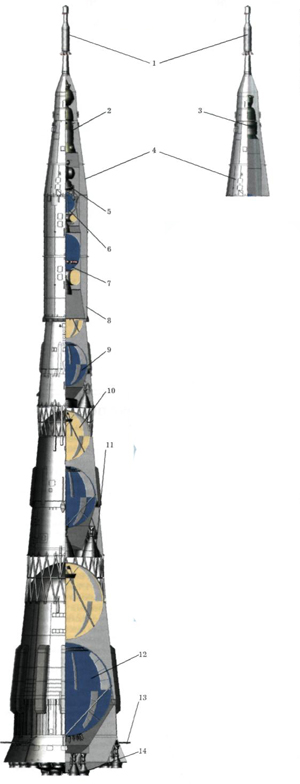The L-3 (N1-L3) (Ë-3 (Í1-Ë3)) space program
The L-3 (Ë-3) or N1-L3 (Í1-Ë3) program was intended for a manned flight to the moon and landing on its surface. Program was implemented in 1964-1974. The main goal of the program was to ensure priority of USSR in the first manned landing on the moon surface. But the goal was not achieved. An A-3 (ËÐÊ) lunar rocket complex was created for performance of this program, which was initially to be launched on the Earth orbit with N-1 launch vehicle.
The development of the ËÐÊ began at construction department-1 in 1964 under the leadership of S.P. Korolev, later on it was being developed under the leadership of V.P. Mishin. The L-3 ËÐÊ consisted lunar orbiter (ËOK), lunar spacecraft (ËK), G booster rocket and D braking rocket. The ËÐÊ was intended for flight of two cosmonauts to the moon in the lunar orbiter, landing of one cosmonaut in the lunar spacecraft on the moon surface and the cosmonauts’ return to the Earth. The total mass of the ËÐÊ reached 95 tons; the length of the entire L-3 complex was 30 meters. The ËOK was developed and designed considering experience of Soyuz spacecraft design and externally was similar to it, but practically it was absolutely new vehicle. The ËOK consisted of descent module, habitation module, instrument-assembly module (ÏÀÎ), propulsion system (ÄÎÊ), I rocket unit and power bay (ÝÎ). The cosmonauts had to perform the flight without spacesuits.
Launch of the first ËOK test unmanned mock-up as a part of the L-3 ËÐÊ was performed on June, 27, 1971 when performing the third launch of N-1 launch vehicle. The second launch of unmanned ËOK (the first nominal spacecraft) also carried by L-3 ËÐÊ launch vehicle was performed on November, 23, 1972 when performing the fourth launch of N-1 launch vehicle. But due to failures of the launch vehicle test flights to the moon were not performed. The 11F91 lunar spacecraft consisted of two separable parts: lunar landing assembly (ËÏÀ) and lunar take off unit (ËÂÀ). The ËÏÀ was designed for landing of lunar spacecraft on the moon surface. The ËÂÀ was located atop of the ËÏÀ. One cosmonaut in Krechet-94 spacesuit was supposed to be inside of the lunar spacecraft.
An T2K experimental lunar spacecraft was created in order to perform tests of unmanned lunar spacecraft on the Earth orbit. For the first time the T2K vehicle was launched on the orbit on November 24, 1970 carried by Soyuz launch vehicle (Cosmos-379). Subsequently two test flights of the spacecraft were performed on the Earth orbit (Cosmos-398 and Cosmos-434).
20 cosmonauts were being trained on (10 cosmonauts from Air Force and 10 cosmonauts from the ÖÊÁÝÌ). 4 test launches of N-1 launch vehicle were performed in 1969-1972, but all of them resulted in a failure of the first stage of the booster. Activities on N1-L3 program were laid off in May, 1974. The program was completely closed in March, 1976 due to active start of Buran program development.



